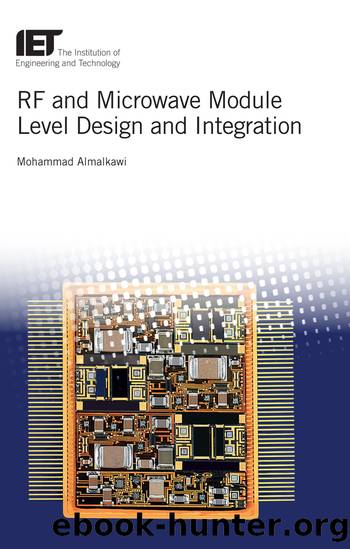RF and Microwave Module Level Design and Integration by Mohammad Almalkawi;

Author:Mohammad Almalkawi; [Неизв.]
Language: eng
Format: epub
ISBN: 9781785613593
Publisher: Institution of Engineering & Technology
Published: 2019-12-04T21:00:00+00:00
5.6 PCB and laminate design considerations
Crosstalk between closely spaced signal interconnects occurs due to the mutual capacitance and mutual inductance couplings. Identifying the coupling type at the circuit traces is important to choose the suitable shielding technique. Coupling mitigation methods for inductive and capacitive coupling are different and most of the times are in conflict.
The media of an RF module and its related characteristics have a significant impact on shaping the EM fields within the module environment and thereby the overall system performance. In particular, multilayer laminates are essential components in the design of compact RF modules that usually encompass routing traces and matching elements as embedded passives. New laminate fabrication processes are capable of producing more than ten layers with high accuracies in terms of layer-to-layer registration and material stack thicknesses. The increasing demand on new laminate technologies exhibiting new thicknesses of metal layers and new dielectric material stacks to allow shrinkage of the total package sizes has led into packing the routing traces closer to each other and scaling down the width of the metal traces along with the layers thicknesses to some extent. However, this exacerbates the influence of EM parasitic coupling between the routing traces, especially, the capacitive coupling.
High impedance sources contribute significantly to the near-zone electric field crosstalk, and low impedance sources (e.g., long trace loops) contribute to the near-zone magnetic-field coupling. With the knowledge of such facts, one can potentially estimate the distribution/pattern of the near-zone electric and magnetic emissions so that countermeasures can be taken to protect a given design. To identify crosstalk due to electric/capacitive coupling, one can look at the high voltage or the low current location on the module interconnects to identify the source of such coupling. Electric coupling will appear as a current source in parallel with the victim trace, while a magnetic coupling will appear as a voltage source at the victim trace.
Capacitive coupling is usually encountered in closely spaced traces and can be mitigated by shielding the aggressor or victim trace using grounded conductive walls (e.g., adding via fence between the traces and connecting the shielding fence to the ground of the module). The shield must be grounded to provide a low impedance path to the electric field. Additionally, capacitive coupling increases with increasing frequency and decreases by increasing the separation between the traces.
Inductive coupling, however, can be identified by finding the high current location on the traces since magnetic-field lines are generated around current carrying conductors. The cross-sectional exposure of the coupled traces is an important factor in determining the amount of inductive coupling which increases by increasing the number of the crossing field lines. Similar to capacitive coupling, inductive coupling increases with frequency and decreases by increasing the separation between the traces. Moreover, inductive coupling can be alleviated by twisting the traces to eliminate the net flux; however, this may not be a practical option for planar PCB traces. Another shielding technique could be surrounding the aggressor trace with a magnetic material to divert the magnetic flux.
Download
This site does not store any files on its server. We only index and link to content provided by other sites. Please contact the content providers to delete copyright contents if any and email us, we'll remove relevant links or contents immediately.
| Automotive | Engineering |
| Transportation |
Whiskies Galore by Ian Buxton(41524)
Introduction to Aircraft Design (Cambridge Aerospace Series) by John P. Fielding(32881)
Small Unmanned Fixed-wing Aircraft Design by Andrew J. Keane Andras Sobester James P. Scanlan & András Sóbester & James P. Scanlan(32567)
Craft Beer for the Homebrewer by Michael Agnew(17926)
Turbulence by E. J. Noyes(7690)
The Complete Stick Figure Physics Tutorials by Allen Sarah(7134)
Kaplan MCAT General Chemistry Review by Kaplan(6584)
The Thirst by Nesbo Jo(6432)
Bad Blood by John Carreyrou(6270)
Modelling of Convective Heat and Mass Transfer in Rotating Flows by Igor V. Shevchuk(6218)
Learning SQL by Alan Beaulieu(6025)
Weapons of Math Destruction by Cathy O'Neil(5819)
Man-made Catastrophes and Risk Information Concealment by Dmitry Chernov & Didier Sornette(5638)
Digital Minimalism by Cal Newport;(5383)
Life 3.0: Being Human in the Age of Artificial Intelligence by Tegmark Max(5181)
iGen by Jean M. Twenge(5149)
Secrets of Antigravity Propulsion: Tesla, UFOs, and Classified Aerospace Technology by Ph.D. Paul A. Laviolette(4974)
Design of Trajectory Optimization Approach for Space Maneuver Vehicle Skip Entry Problems by Runqi Chai & Al Savvaris & Antonios Tsourdos & Senchun Chai(4837)
Electronic Devices & Circuits by Jacob Millman & Christos C. Halkias(4739)
